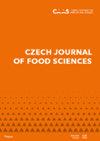Impact of lard-based diacylglycerols on the quality and sensory characteristics of emulsion-type sausage
IF 1
4区 农林科学
Q4 FOOD SCIENCE & TECHNOLOGY
引用次数: 1
Abstract
: The objective of this study was to evaluate the effects of fat levels (200 g·kg –1 meat and 500 g·kg –1 meat) and types [lard, glycerolised lard (GL), and purified glycerolised lard (PGL)] on the quality and sensory characteristics of emulsion-type sausages. As observed, at the same type of fat, the low-fat sausage (200 g·kg –1 meat) had a significantly higher L *-value (lightness) and lower cooking loss and total expressible fluid ( P < 0.05) than the high-fat sausage (500 g·kg –1 meat) and exhibited a denser and more homogeneous microstructure. Additionally, T 23 (relaxation time) of the low-fat sausage shifted toward a slower relaxation time, and higher A 23 (peak area) was found, which suggested the water mobility was restricted. However, at the same fat content, the low-GL and low-PGL sausages showed bet-ter textural properties and superior overall acceptability from sensory evaluation compared with the low-lard sausage ( P < 0.05). Still, they have no significant differences ( P > 0.05). Therefore, lard-based diacylglycerol could be effectively applied as a fat replacer in emulsion-type sausages with low-fat contents to produce healthier meat products.猪油基甘油对乳化型香肠品质和感官特性的影响
:本研究的目的是评估脂肪水平(200 g·kg–1肉和500 g·kg-1肉)和类型[猪油、甘油化猪油(GL)和纯化甘油化猪脂(PGL)]对乳液型香肠质量和感官特性的影响。正如观察到的那样,在相同类型的脂肪下,低脂香肠(200 g·kg–1肉)比高脂肪香肠(500 g·kg-1肉)具有显著更高的L*值(亮度)、更低的烹饪损失和总可表达液体(P<0.05),并表现出更致密、更均匀的微观结构。此外,低脂香肠的T 23(松弛时间)向较慢的松弛时间移动,并且发现较高的a 23(峰面积),这表明水的流动性受到限制。然而,在相同的脂肪含量下,与低猪油香肠相比,低GL和低PGL香肠表现出更好的质地特性和感官评价的整体可接受性(P<0.05)。但它们之间没有显著差异(P>0.05)。因此,以猪油为基础的二酰甘油可以有效地用作低脂乳液型香肠的脂肪替代品,生产出更健康的肉制品。
本文章由计算机程序翻译,如有差异,请以英文原文为准。
求助全文
约1分钟内获得全文
求助全文
来源期刊

Czech Journal of Food Sciences
Food Science & Technology, Chemistry-食品科技
CiteScore
2.60
自引率
0.00%
发文量
48
审稿时长
7 months
期刊介绍:
Original research, critical review articles, and short communications dealing with food technology and processing (including food biochemistry, mikrobiology, analyse, engineering, nutrition and economy). Papers are published in English.
 求助内容:
求助内容: 应助结果提醒方式:
应助结果提醒方式:


